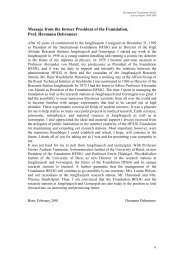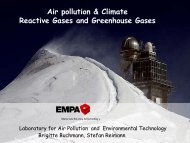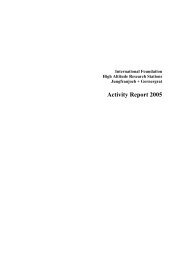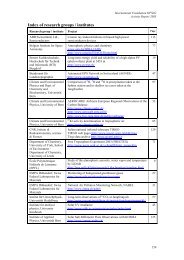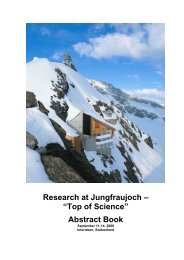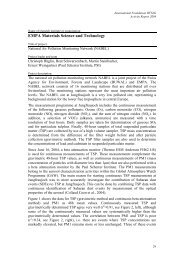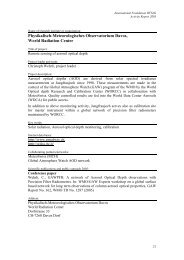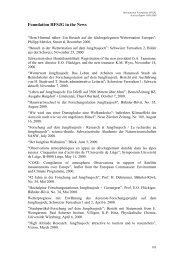National Air Pollution Monitoring Network (NABEL) - International ...
National Air Pollution Monitoring Network (NABEL) - International ...
National Air Pollution Monitoring Network (NABEL) - International ...
You also want an ePaper? Increase the reach of your titles
YUMPU automatically turns print PDFs into web optimized ePapers that Google loves.
<strong>International</strong> Foundation HFSJGActivity Report 2012Name of research institute or organization:Empa, Swiss Federal Laboratories for Materials Science and TechnologyTitle of project:<strong>National</strong> <strong>Air</strong> <strong>Pollution</strong> <strong>Monitoring</strong> <strong>Network</strong> (<strong>NABEL</strong>)Project leader and team:Dr. Martin Steinbacher, Dr. Christoph Hüglin (project leader)Project description:The <strong>National</strong> <strong>Air</strong> <strong>Pollution</strong> <strong>Monitoring</strong> <strong>Network</strong> (<strong>NABEL</strong>) is run by Empa together with theSwiss Federal Office for the Environment (BAFU/FOEN). The <strong>NABEL</strong> network wasestablished in 1978 with initially 8 sites emerging from activities that started already in 1968as contributions to international WMO and OECD observation networks. In-situmeasurements by Empa at Jungfraujoch began in 1973. Early activities mainly focused onsulphur dioxide and particulate matter. In 1990/1991 the <strong>NABEL</strong> network was extended to 16monitoring stations that are distributed all over Switzerland. These monitoring stationsrepresent the most important air pollution levels from kerbside to remote free troposphericbackground. The <strong>NABEL</strong> site at Jungfraujoch is a very low polluted site, representing abackground station for the lower free troposphere in central Europe.The current measurement program at Jungfraujoch includes continuous in-situ analyses ofozone (O 3 ), carbon monoxide (CO), nitrogen monoxide (NO), nitrogen dioxide (NO 2 ), thesum of nitrogen oxides (NO y ), sulphur dioxide (SO 2 ), methane (CH 4 ) and carbon dioxide(CO 2 ). These data are stored as 10-min averages. Furthermore, the concentrations of CH 4 arealso measured in 24 min intervals along with nitrous oxide (N 2 O) and sulphur hexafluoride(SF 6 ). Molecular hydrogen (H 2 ) is also semi-continuously monitored in 30-min intervals. Anextended set of halocarbons and a selection of volatile organic compounds (VOCs) (alkanes,aromatics) are measured with a time resolution of two hours. The concentrations ofparticulate matter < 10 µm (PM10) are determined both continuously and in 24-hourintegrated samples. Daily samples are taken to quantify particulate sulphur.The long-term evolution of tropospheric ozone mole fractions at Jungfraujoch (see Figure 1)and other elevated measurement stations is of vivid scientific interest as ozone is an efficientgreenhouse gas and plays a crucial role in tropospheric chemistry. Being a so-calledsecondary air pollutant produced in the atmosphere from precursors such as VOCs andnitrogen oxides under the presence of sunlight, its variations over time mainly reflect theresponse to the pronounced changes in the ozone precursors during the past decades. Variousinternational efforts were recently made to analyze the long-term changes of ozone over theAlpine region [Gilge et al., 2010], over Europe [Logan et al., 2012], and over the NorthernHemisphere [Parrish et al., 2012].Gilge et al. [2010] focused on the measurement stations of the DACH-cooperation (Germany:D, Austria: A, Switzerland: CH), namely Zugspitze, Hohenpeissenberg, Sonnblick andJungfraujoch. Data from 1995 till 2007 were considered in this publication to have aconsistent dataset for all stations. Linear trend analyses were performed for a variety ofpercentile classes. Jungfraujoch (the most elevated of the stations) reveals consistent butinsignificant negative trends for all percentiles while the lower percentiles at the other lesselevated stations slightly increase and the upper percentiles come down. The differentpatterns can be explained by the more dominant influence of ozone loss due to NO titration atlower altitudes. This loss process mainly plays a role in polluted environments in theatmospheric boundary layer (ABL) while air masses from the ABL only occasionally reachthe Jungfraujoch. Reduced NO emissions in the ABL make the loss process less prevalentand thus favour positive ozone trends. The specific analysis by Gilge et al. [2010] for63
<strong>International</strong> Foundation HFSJGActivity Report 2012Jungfraujoch also pointed out that the 1986-1994 trend at Jungfraujoch was (insignificantly)negative due to the observation of high mole fractions in the early years of the time series.Figure 1. Time series of hourly (grey), daily (blue) and monthly (red) averages ofcontinuously measured in-situ ozone at Jungfraujoch from 1988 to 2012.Logan et al. [2012] carefully analysed ozone time series in the free troposphere from variousnetworks (ozone sondes, aircrafts, and Alpine surface sites) back to the 1970ies.Intercomparison of the various datasets revealed very coherent features above Europe sinceabout 1998, providing good confidence in the data quality of the various measurements. Priorto 1998, differences between the time series were more pronounced due to less precisemeasurement equipment and less sophisticated quality control procedures. Within <strong>NABEL</strong>, acomplete traceability chain for ozone was established in 1993 when purchasing a standardreference photometer while the measurements before relied on comparison with transferinstruments that were calibrated by the manufacturer. Overall, Logan et al. [2012] state thatthe trends in ozone precursor emissions and of ozone in the lowermost stratosphere (fromwhere ozone can be transported into the free troposphere) cannot fully explain the observedozone evolution. More dedicated modeling efforts might be needed to get better insight in theunderlying processes.A similar point is made by Parrish et al. [2012] who also aim at providing robust ozonedatasets for comparison with model outputs. They studied time series from six European lowpolluted and elevated measurement sites along with three North American and two Asianlong-term ozone time series. The authors state that systematic long-term measurement-modelcomparisons covering various decades are necessary to fully understand the ozone budget.Parrish et al. [2012] conclude that the ozone time series increased rather linearly at all sitesin the last decades of the last century while a remarkable slow down can be observedafterwards leading to decreasing growth rates. The slowdown of the growth rate canparticularly be seen over Western and Central Europe while it is less pronounced over NorthAmerica and Japan. Within this study, <strong>NABEL</strong>’s continuous ozone time series since 1990were jointly analyzed with sporadic historic data taken in summer 1934 and 1938 atJungfraujoch (taken from Crutzen [1988] and Staehelin et al. [1994]) (see Figure 2). Thiscombined view confirms the significant increase of ozone at Jungfraujoch in the last centurywith an approximate doubling of the ozone burden between the 1930ies and the year 2000.64
<strong>International</strong> Foundation HFSJGActivity Report 2012Figure 2. Time series of seasonal ozone averages at Jungfraujoch from 1990 to 2010 alongwith sporadic historic data from summer 1934 and summer 1938. The solid lines illustratelinear regressions for the data prior to 2001, the dotted lines indicate the quadraticregressions for the 1990 to 2010 datasets. Figure courtesy of David Parrish [Parrish et al.,2012].ReferencesCrutzen, P. J. (1988), Tropospheric ozone: an overview, in Tropospheric Ozone, edited by I.S. A. Isaksen, pp. 47-56, Reidel Publishing Co., Dordrecht.Gilge, S., C. Plass-Duelmer, W. Fricke, A. Kaiser, L. Ries, B. Buchmann, and M. Steinbacher(2010), Ozone, carbon monoxide and nitrogen oxides time series at four Alpine GAWmountain stations in Central Europe, Atmos. Chem. Phys., 10, 12295-12316.Logan, J. A., et al. (2012), Changes in ozone over Europe: analysis of ozone measurementsfrom sondes, regular aircraft (MOZAIC) and alpine surface sites, J. Geophys. Res., 117,D09301, doi: 09310.01029/02011JD016952.Parrish, D. D., et al. (2012), Long-term changes in lower tropospheric baseline ozoneconcentrations at northern mid-latitudes, Atmos. Chem. Phys., 12, 11485-11504.Staehelin, J., J. Thudium, R. Buehler, A. Volz-Thomas, and W. K. Graber (1994), Trends insurface ozone concentrations at Arosa (Switzerland), Atmos. Environ., 28(1), 75-87.65
<strong>International</strong> Foundation HFSJGActivity Report 2012Key words:Atmospheric chemistry, air quality, trace gases, long-term monitoringInternet data bases:http://www.empa.ch/nabelhttp://www.umwelt-schweiz.ch/buwal/de/fachgebiete/fg_luft/luftbelastung/index.htmlCollaborating partners/networks:Bundesamt für Umwelt (BAFU)/ Federal Office for the Environment (FOEN)Global Atmosphere Watch (GAW)Labor für Atmosphärenchemie, Paul Scherrer InstitutMeteoSchweizClimate and Environmental Physics, University of BernScientific publications and public outreach 2012:Refereed journal articles and their internet accessBrunner, D., Henne, S., Keller, C. A., Reimann, S., Vollmer, M. K., O'Doherty, S., Maione, M., An extendedKalman-filter for regional scale inverse emission estimation, Atmospheric Chemistry and Physics, 12(7), 3455-3478, 2012.http://www.atmos-chem-phys.net/12/3455/2012/acp-12-3455-2012.htmlBuchmann, B., Research at Jungfraujoch supports policy, Public Service Review: European Science &Technology 2012, 14, 190-191, 2012.http://www.publicservice.co.uk/article.asp?publication=European%20Science%20and%20Technology&id=554&content_name=Environment%20and%20Energy&article=18998Conen, F., Henne, S., Morris, C. E., Alewell, C., Atmospheric ice nucleators active ≥ −12 °C can be quantified onPM10 filters, Atmospheric Measurement Techniques, 5(2), 321-327, 2012.http://www.atmos-meas-tech.net/5/321/2012/amt-5-321-2012.htmlKeller, C. A., Hill, M., Vollmer, M. K., Henne, S., Brunner, D., Reimann, S., O’Doherty, S., Peter, T., Maione,M., Ferenczi, Z., Haszpra, L., Manning, A. J., Peter, T., European emissions of halogenated greenhouse gasesinferred from atmospheric measurements. Environmental Science & Technology, 46(1), 217-225, 2012.http://pubs.acs.org/doi/full/10.1021/es202453jKristiansen, N. I., Stohl, A., Prata, A. J., Bukowiecki, N., Dacre, H., Eckhardt, S., Henne, S., Hort, M. C.,Johnson, B. T., Marenco, F., Neininger, B., Reitebuch, O., Seibert, P., Thomson, D. J., Webster, H. N., Weinzierl,B., Performance assessment of a volcanic ash transport model mini-ensemble used for inverse modeling of the2010 Eyjafjallajökull eruption, Journal of Geophysical Research, 117, D00U11, doi:10.1029/2011JD016844,2012.http://onlinelibrary.wiley.com/doi/10.1029/2011JD016844/abstractLogan, J. A., Staehelin, J., Megretskaia, I. A., Cammas, J. P., Thouret, V., Claude, H., De Backer, H., Steinbacher,M., Scheel, H. E., Stübi, R., Fröhlich, M., Derwent, R., Changes in ozone over Europe: Analysis of ozonemeasurements from sondes, regular aircraft (MOZAIC) and alpine surface sites, Journal of Geophysical Research,117, D09301, doi: 09310.01029/02011JD016952, 2012.http://www.agu.org/pubs/crossref/2012/2011JD016952.shtmlPandey Deolal, S., Brunner, D., Steinbacher, M., Weers, U., Staehelin, J., Long-term in situ measurements of NOxand NOy at Jungfraujoch 1998–2009: time series analysis and evaluation, Atmospheric Chemistry and Physics,12(5), 2551-2566, 2012.http://www.atmos-chem-phys.net/12/2551/2012/acp-12-2551-2012.htmlParrish, D. D., Law, K. S., Staehelin, J., Derwent, R., Cooper, O. R., Tanimoto, H., Volz-Thomas, A., Gilge, S.,Scheel, H.-E., Steinbacher, M., Chan, E., Long-term changes in lower tropospheric baseline ozone concentrationsat northern mid-latitudes, Atmospheric Chemistry and Physics, 12, 11485-11504, http://dx.doi:10.5194/acp-12-11485-2012, 2012.http://www.atmos-chem-phys.net/12/11485/2012/acp-12-11485-2012.htmlRuckstuhl, A. F., Henne, S., Reimann, S., Steinbacher, M., Vollmer, M. K., O'Doherty, S., Buchmann, B.,Hueglin, C., Robust extraction of baseline signal of atmospheric trace species using local regression, AtmosphericMeasurement Techniques, 5(11), 2613-2624, 2012.http://www.atmos-meas-tech.net/5/2613/2012/amt-5-2613-2012.htmlThevenon, F., Chiaradia, M., Adatte, T., Hueglin, C., Poté, J., Characterization of modern and fossil mineral dusttransported to high altitude in the western alps: saharan sources and transport patterns, Advances in Meteorology,Article ID 674385, doi:10.1155/2012/674385, 2012.http://www.hindawi.com/journals/amet/2012/674385/66
<strong>International</strong> Foundation HFSJGActivity Report 2012Wilson, R. C., Fleming, Z. L., Monks, P. S., Clain, G., Henne, S., Konovalov, I. B., Szopa, S., Menut, L., Haveprimary emission reduction measures reduced ozone across Europe? An analysis of European rural backgroundozone trends 1996–2005, Atmospheric Chemistry and Physics, 12(1), 437-454, 2012.http://www.atmos-chem-phys.net/12/437/2012/acp-12-437-2012.htmlConference papersHueglin, C., Measurements of ambient air in Switzerland (<strong>NABEL</strong>) and Europe (EMEP), HS_CourseOeschgerzentrum/Medizinische Fakultät Uni Bern/Empa, Dübendorf, Switzerland, January 23-26, 2012.Parrish, D. D., K.S. Law, J. Staehelin, R. Derwent, O.R. Cooper, H. Tanimoto, A. Volz-Thomas, S. Gilge, H.-E.Scheel, M. Steinbacher, E. Chan, Earlier seasonal maximum in lower tropospheric ozone at northern mid-latitudes,2012 AGU Fall Meeting, San Francisco, USA, December 3-7, 2012.Steinbacher, M., Long-term continuous ground-based in-situ trace gas observations at Jungfraujoch, NDACC-IRWG/TCCON 2012 Meeting, Wengen, Switzerland, June 11-13, 2012.Steinbacher, M., Neues von der DACH-Station Jungfraujoch, Sitzung der GAW-DACH-Arbeitsgruppe, Munich,Germany, September 12-13, 2012.Steinbacher, M., Ozone in the free troposphere - Results from recent JFJ studies, Sitzung der GAW-DACH-Arbeitsgruppe, Munich, Germany, September 12-13, 2012.Sturm, P., B. Tuzson, S. Henne, D. Brunner, J. Mohn, M. Steinbacher, B. Buchmann, L. Emmenegger, Trackingisotopic signatures of CO2 at Jungfraujoch with laser spectroscopy: analytical improvements and exemplaryresults, JESIUM 2012, Leipzig, Germany, September 2-7, 2012.Data books and reportsBAFU 2012: <strong>NABEL</strong> – Luftbelastung 2011. Messresultate des <strong>National</strong>en Beobachtungsnetzes fürLuftfremdstoffe (<strong>NABEL</strong>). pp. 128, Bundesamt für Umwelt, Bern. Umwelt-Zustand Nr. 1221, 2012.Magazine and Newspapers articles“Hochalpine Top-Wissenschaft, 75 Jahre Sphinx-Observatorium auf dem Jungfraujoch”, Neu Zürcher Zeitung,June 12, 2012.“FCKW-Ersatzstoffe: Gut für die Ozonschicht, schlecht für das Klima”, SVG-Journal, April 20, 2012.“Forscher: FKW ins Montrealer Protokoll aufnehmen”, chemie plus, March 08, 2012.“Auf 3500 Metern den Puls der Atmosphäre messen”, Espazium, May 04, 2012.“Auf 3500 Metern den Puls der Atmosphäre messen”, www.bluewin.ch, May 04, 2012.“Den Puls der Atmosphäre messen”, Walliser Bote, May 05, 2012.Address:EmpaLaboratory for <strong>Air</strong> <strong>Pollution</strong>/Environmental TechnologyUeberlandstrasse 129CH-8600 DübendorfContacts:Martin SteinbacherTel.: +41 58 765 4048Fax: +41 58 765 1122e-mail: martin.steinbacher@empa.chURL: http://www.empa.ch/nabel67



